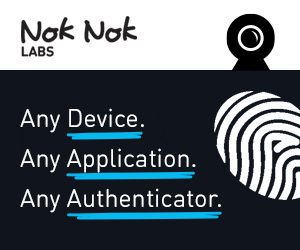Mobile biometric technology is more than just unlocking your smartphone with your fingerprint, face, or iris. Many of the same innovations that have made biometrics flexible and affordable enough to integrate into consumer-facing hardware have also allowed for strong biometric identity to become a more prominent aspect of vertical markets on a global scale.

This week, for Mobile Biometrics Month 2017, we are going to look at three different markets where the emergence of mobile biometric technology is making a big difference.
Commerce
 Financial applications of mobile biometrics are easily the most visible use case when it comes to mobile biometrics. Leveraging the multimodal consumer mobile devices mentioned above, financial services providers have been able to make payment and online-banking transactions more convenient and secure than ever before.
Financial applications of mobile biometrics are easily the most visible use case when it comes to mobile biometrics. Leveraging the multimodal consumer mobile devices mentioned above, financial services providers have been able to make payment and online-banking transactions more convenient and secure than ever before.
Mobile wallets like Samsung Pay and Apple Pay are the most prominently visible applications for biometrics in this arena, allowing users to use fingerprint or iris biometrics for transaction authentication for both Point-of-Sale and online payments. In today’s world of tap-to-pay debit and credit cards, it’s difficult to see the small margin of convenience this adds at the payment terminal, but in an online scenario it simply cannot be matched. Making an online payment by touching your thumb to your phone’s home button runs circles around the alternative form-filling option. And what’s more, mobile wallets generally save financial payment info on your device, never sharing it, making it a more private and secure option than allowing your browser to save your payment info.
In terms of mobile banking, the space has matured into a multimodal landscape in which customers can choose how they prefer to authenticate. Here, once again you have the convenience of not having to input login data, while also being given flexibility in terms of which biometrics you would like to submit, be they finger, iris, voice, face, Eyeprint, or a multi-factor combination involving any of the above. USAA’s mobile app has long been an example of this concept at work, offering users the option to login via face, fingerprint, or voice biometrics, and even the choice to combine factors for scalable security.
Elections
 Biometrics are becoming an important part of the elections process around the world as many governments turn to electronic voting in order to make the democratic process more efficient and accountable. The Philippines, Zimbabwe, Kenya, Sierra Leone, Ghana, Egypt and other countries have all either implemented biometrics in their elections or are in the process of doing so as they gear up to vote.
Biometrics are becoming an important part of the elections process around the world as many governments turn to electronic voting in order to make the democratic process more efficient and accountable. The Philippines, Zimbabwe, Kenya, Sierra Leone, Ghana, Egypt and other countries have all either implemented biometrics in their elections or are in the process of doing so as they gear up to vote.
A challenge that has been encountered when undergoing biometric elections has to do with the registration and enrollment process. Many of the countries where biometric voting is catching on are highly rural, have difficult to travel infrastructure, and don’t have a national biometric ID database. This is where mobility comes in: mobile biometric technologies are being deployed that allow elections officials to bring voter enrollment to citizens outside of urban centers.
Mobility aided in the biometric enrollment process for the 2015 Egyptian parliamentary elections, when MorphoTablet devices were used to register voters and verify their identity cards. The biometric tablets, that can be used to scan face and fingerprint biometrics, were initially deployed for voter registration purposes in 2014 after the fall of dictator Hosni Mubarak.
National ID
 India’s Aadhaar national ID program is the largest and most ambitious citizen identification project of its kind, with over a billion people registered. Mobility has played a role here similar to the one it’s played in biometric elections, with mobile biometrics hardware brought to rural residents so that they can register their face, fingerprint, and iris data. The use of Aadhaar biometrics is wide ranging in application: used for time and attendance in government and healthcare; implemented as a key aspect of food subsidies; even leveraged as a payments method through the newly launched Aadhaar Pay naked payments system. But as biometrics are becoming more accessible to consumers, the applications of the Aadhaar database are expanding even further.
India’s Aadhaar national ID program is the largest and most ambitious citizen identification project of its kind, with over a billion people registered. Mobility has played a role here similar to the one it’s played in biometric elections, with mobile biometrics hardware brought to rural residents so that they can register their face, fingerprint, and iris data. The use of Aadhaar biometrics is wide ranging in application: used for time and attendance in government and healthcare; implemented as a key aspect of food subsidies; even leveraged as a payments method through the newly launched Aadhaar Pay naked payments system. But as biometrics are becoming more accessible to consumers, the applications of the Aadhaar database are expanding even further.
Recently we have seen numerous announcements of big name mobile biometric vendors receiving Aadhaar certification for their iris, face and fingerprint technology, much of which has already seen integration in consumer handsets. As these certified solutions grow in number, and are in turn put in the hands of more Indian citizens, we may see a shift toward a new type of biometrically empowered citizen. Whereas the national ID database was used primarily on administrative and government levels, end-users with biometric smartphones can start to take advantage of it too.
Indeed, it’s already starting to happen. At this year’s Mobile World Congress in Barcelona, there was a demonstration of a new solution offered to Aircel subscribers in the region. Thanks to a combination of GSMA Mobile Connect, facial recognition from Safran, and the Aadhaar database, mobile subscribers are able to self-register their devices via selfie – Mobile Connect and facial recognition allowing for the proper assurances on behalf of the government and the MNO. It’s just one of the many ways that connecting national ID to consumer-facing mobile tech can potentially change the way we live our lives in a positive and empowering way.
*
With all the appropriate excitement about new innovations and evolutions in consumer mobility, and how biometrics are finding traction therein, it is important to remember that as industry paradigms, mobility and digital identity are all encompassing. National ID, elections, FinTech – these are only some of the spaces being transformed for the better thanks to mobile biometrics.
*
Be sure to follow us on Twitter to stay on top of all the most important identity management news.
Mobile Biometric Month 2017 is made possible by our sponsors: Precise Biometrics, Aware, Inc., and Nok Nok Labs


Follow Us